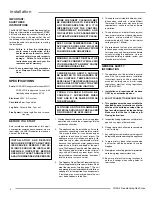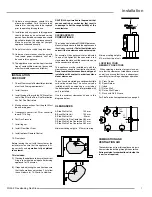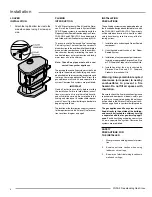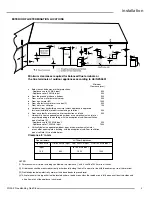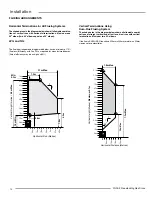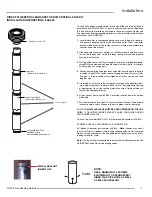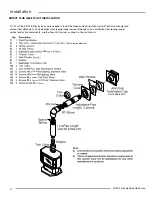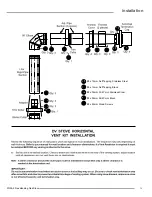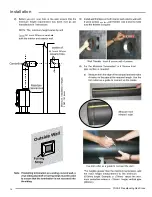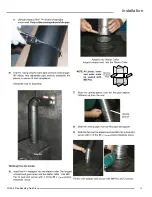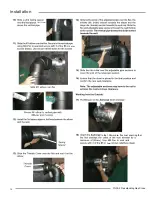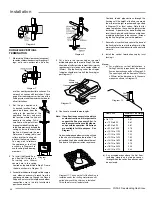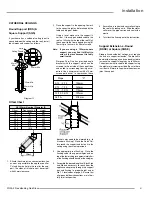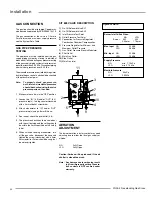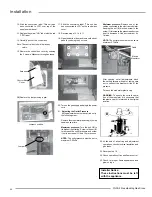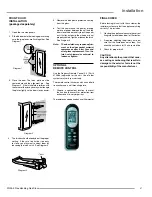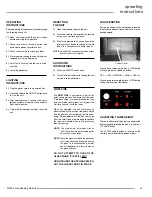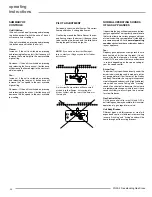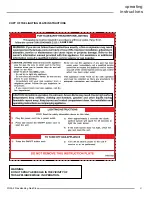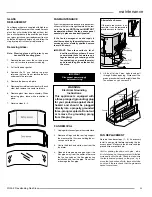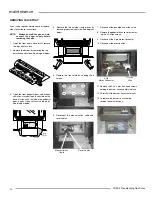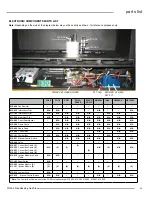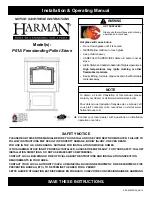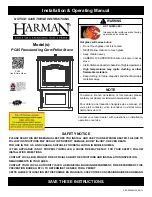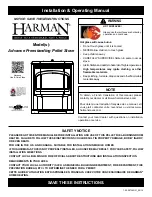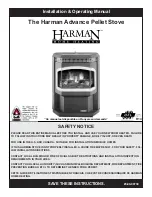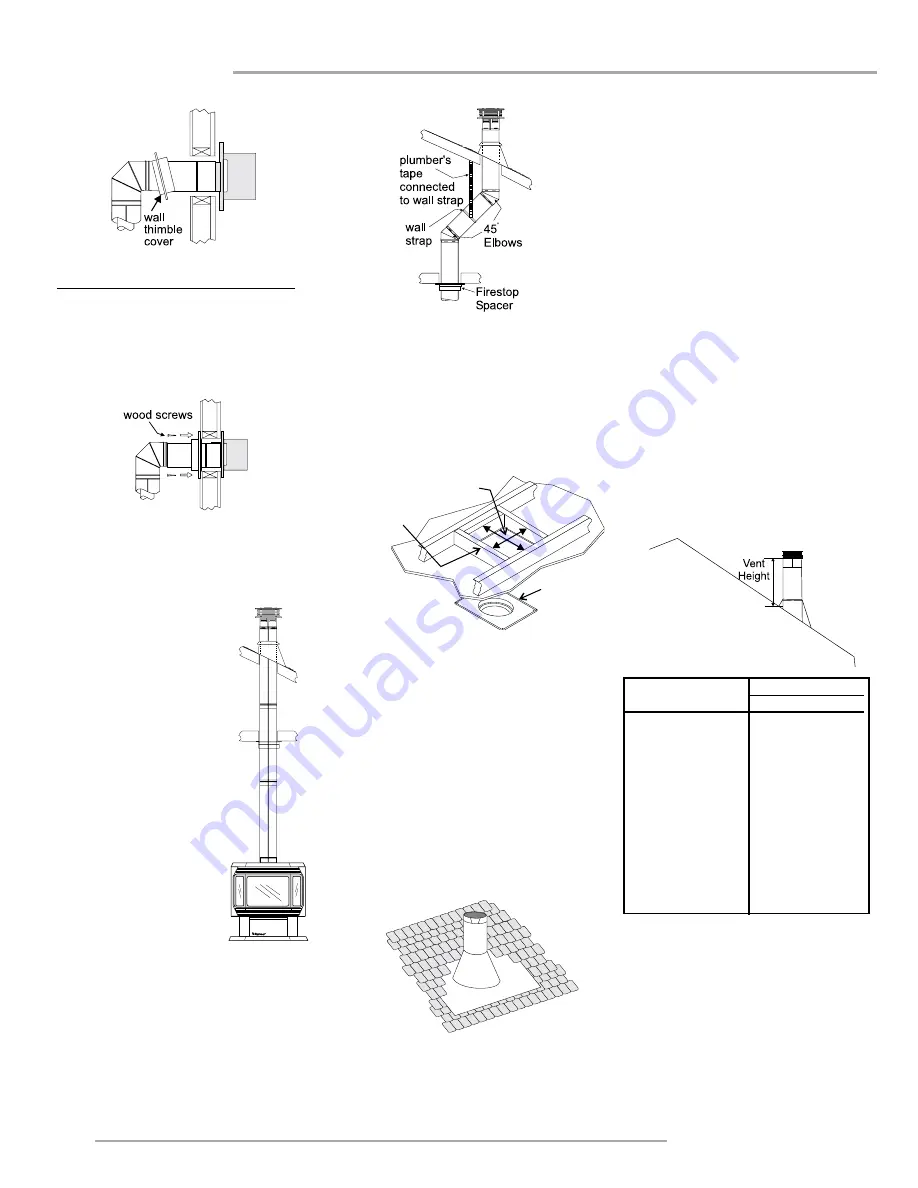
20
FG39-2 Freestanding Gas Stove
installation
Diagram 11: The upper half of the flashing is
installed under the roofing material and not
nailed down until the chimney is installed.
This allows for small adjustments.
6. Continue to assemble pipe lengths.
Note: If an offset is necessary in the attic to
avoid obstructions, it is important to
support the flue pipe every 0.9m, to
avoid excessive stress on the elbows,
and possible separation. Wall straps
are available for this purpose. See
Diagram 7.
Galvanized pipe and elbows may be utilized
in the attic as well as above the roof line. The
galvanized finish is desirable above the roof
line due to its higher corrosion resistance.
Diagram 12
b) Any occupied areas above the first floor,
including closets and storage spaces,
through which the vertical flue passes, must
be enclosed.
Continue to add pipe sections through the
flashing until the height of the flue cap meets
the minimum height requirements specified
in Diagram 12 or local codes. Note that for
steep roof pitches, the vertical height must be
increased. A poor draft, or down drafting can
result from high wind conditions near big trees
or adjoining roof lines, in these cases, increas-
ing the flue height may solve the problem.
7. Ensure flue is vertical and secure the base of
the flashing to the roof with roofing rails, slide
storm collar over the pipe section and seal with
a mastic.
8. Install the vertical termination cap by twist
locking it.
Notes:
a)
For multistorey vertical installations, a
Ceiling Fire stop is required at the second
floor, and any subsequent floor. Diagram 13.
The opening should be framed to 254mm
x 254mm inside dimensions, in the same
manner as shown in Diagram 10.
Roof Pitch Minimum Flue Height
Meters
flat to 7/12
0.61
over 7/12 to 8/12
0.61
over 8/12 to 9/12
0.61
over 9/12 to 10/12
0.76
over 10/12 to 11/12
0.99
over 11/12 to 12/12
1.22
over 12/12 to 14/12
1.52
over 14/12 to 16/12
1.83
over 16/12 to 18/12
2.13
over 18/12 to 20/12
2.29
over 20/12 to 21/12
2.44
firestop
spacer
framing
254mm
square hole
Diagram 10
Diagram 9
Diagram
8
Diagram 7
Diagram 6
or other nearby combustible surfaces. Do
not pack air spaces with insulation. Check
page 9 for the maximum vertical rise of the
flueing system and the maximum horizontal
offset limitations.
2. Set the gas appliance in
its desired location. Drop a
plumb bob down from the
ceiling to the position of the
appliance flue exit, and mark
the location where the flue will
penetrate the ceiling. Drill a
small hole at his point. Next,
drop a plumb bob from the roof
to the hole previously drilled in the
ceiling, and mark the spot where
the flue will penetrate the roof.
Determine if ceiling joists, roof
5. Cut a hole in the roof centred on the small
drilled hole placed in the roof in Step 2. The hole
should be of sufficient size to meet the minimum
requirements for clearance to combustibles of
(32mm) . Slip the flashing under the shingles
(shingles should overlap half the flashing) as
per Diagram 11.
DURA-FLUE VERTICAL
TERMINATION
1. Maintain the 32mm clearances (air spaces)
to combustibles when passing through ceil-
ings, walls, roofs, enclosures, attic rafter,
rafters or other framing will
obstruct the flueing system.
You may wish to relocate
the appliance or to offset,
as shown in Diagram 9 to
avoid cutting load bearing
members.
3. To install the Round Sup-
port Box/Wall Thimble in a
flat ceiling, cut a 254mm
square hole in the ceiling
centred on the hole drilled in Step 2. Frame
the hole as shown in Diagram 10.
4. Assemble the desired lengths of black pipe
and elbows necessary to reach from the
appliance adaptor up though the Round
Support Box. Insure that all pipes and elbow
connections are in the fully twist-locked
position and sealed.
Содержание FG39-LPG2
Страница 15: ...FG39 2 Freestanding Gas Stove 15 installation 1 2m 13mm 13mm 102mm 04 19 18 a ...
Страница 46: ...46 FG39 2 Freestanding Gas Stove ...
Страница 47: ...FG39 2 Freestanding Gas Stove 47 ...

